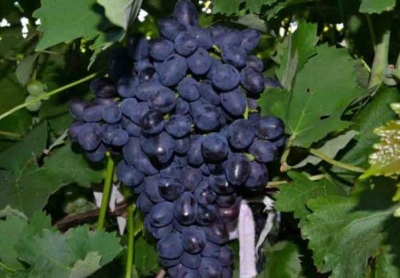
- Authors: Zagorulko Vitaly Vladimirovich
- Berry color: Navy blue
- Taste: harmonious
- Ripening period: early
- Ripening period, days: 110-115
- Frost resistance, ° C: -21
- Bunch weight, g: 600-800
- Flower type: bisexual
- Appeared when crossing: Laura x Codryanka
- Berry shape: oval-ovoid, elongated
Fun is a relatively recent hybrid form of grapes. This is a vigorous dark blue early maturing variety for table use, and it comes from Zaporozhye. The variety has a wide growing geography and an equally wide range of consumption.
Breeding history
The beautiful vine was bred by the Zaporozhye breeder V.V. Zagorulko. The author took as a basis two wonderful varieties with a worthy past and excellent characteristics: white-fruited Laura and dark blue Codryanka. It was important for Zagorulko to get a new hybrid with a certain set of qualities. He fulfilled the tasks set, so soon a hybrid variety with the sonorous name Zabava was presented to winegrowers. Synonym - Laura Black. The grapes are intended for fresh consumption, conservation and winemaking.
Description
This is an early ripening grape with vigorous self-rooted bushes capable of growing 80% fruiting shoots by 3-4 meters per year. Shoots are covered with dark green five-lobed leaves with a strongly dissected border.
Ripening period
The hybrid belongs to the early maturing varieties. The approximate time for reaching the technical ripeness of berries is 110-115 days from the beginning of bud opening.
Bunches
Large conical bunches have a dense structure and a weight of 600-800 grams, which, of course, is not the limit. Under ideal conditions, the bush is capable of producing brushes weighing up to 1.5 kg. Peeling is possible, but only with prolonged rains during the flowering period. Decorative qualities, presentation and transportability are at a high level
Berries
Large dark blue berries with an oval-ovoid elongated shape contain 3 seeds. Berries rarely crack. The juicy and crispy flesh is firm, sweet and covered with a firm skin that is hardly noticeable when eating. Fruit weight - 7-10 grams, size - 32-35 by 20-22 mm. Sugar content - 20%, acidity - 9 g / l.
Taste
Zabava's taste is harmonious, sweet, with a slight sourness, dessert.
Yield
A high-yielding hybrid is capable of giving 25-30 kilograms per bush. Industrial horticultural farms receive up to 150 centners per hectare.


Growing features
The hybrid is unpretentious, compatible with most rootstocks. For its cultivation, standard planting and care methods are used. Compliance with agricultural technology allows you to get stable and high yields. The vine can be propagated by layering. Cuttings root well, and seedlings have a high survival rate.
Landing
In the southern regions, seedlings are planted in the spring, after the end of the morning frost, as well as in the fall.In regions with a temperate climate, autumn planting of cuttings and seedlings of Fun is not recommended, since the onset of cold weather can happen before the seedling takes root.
The landing site should be on southern slopes or in areas well protected from cold winds and drafts. Usually this is a building wall, a high solid fence. The soil is recommended fertile, light (sandy or sandy loam), breathable. The close occurrence of groundwater to the roots is unacceptable: when planting, one must remember the size and depth of penetration of the adult root system. The distance from the retaining wall is approximately 2.5 m. The same distance is maintained between adjacent bushes.

Pollination
The hybrid does not need additional pollination, since it blooms with bisexual flowers.
Pruning
Vigorous bushes need mandatory formative autumn pruning. After harvesting and foliage falling off, the shoots are shortened, leaving 6-8 eyes. The total load on the bush is 35-45 eyes. To obtain good yields, it is necessary to normalize: 1 bunch goes for 1 shoot. Excess ones are removed in the state of inflorescences. In the spring, sanitary pruning is carried out, during which sick, damaged and dry shoots are removed.

Watering
For Fun, abundant but rare watering is vital. During the growing season, trunks are shed up to 5 times. The first 2 procedures are performed after bud break: before and after flowering. Then it is watered during the growth of the berry, when it resembles a pea in size. The following watering is carried out in the fall: after harvesting and before shelter for the winter.


Top dressing
Fertilize the bushes several times a year. In spring, the plant needs nitrogen and phosphorus, zinc and potassium. During the ripening period of the crop, the vine is fed with complex specialized fertilizers. In late autumn, organic matter is introduced into the soil: humus, bird droppings, compost.
Frost resistance and the need for shelter
Zabava grapes have good frost resistance indicators of -21 degrees. This means that he does not need shelter in warm regions. In frosty winters, protection is required. The vine is removed from the support, bent to the ground, tied and covered with sawdust, reeds, hay, etc. Throw burlap, agrofibre, film on top, then covered with earth.

Diseases and pests
The variety is distinguished by its tolerance to powdery mildew and gray rot, but is defenseless against mildew. The peel of the fruit cannot resist the wasps attracted by the sweet aroma of the tasty pulp. In addition, leaf rollers, aphids, spider mites and grape mites can attack the vine.To avoid these misfortunes, do not neglect preventive measures.
Against fungal diseases, spraying with fungicides or copper sulfate is carried out. Insecticides are used in pest control, but gauze bags, destruction of nests, spraying with table vinegar will help against wasps.

If a grape is exposed to any disease or insect, this always affects its appearance.
Storage
Fruits keep well in refrigerators or cool, ventilated rooms. They can lie for up to 2 months.











































































